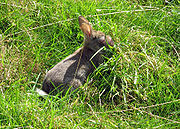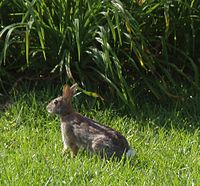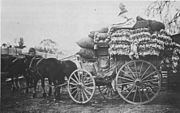
Rabbit
About this schools Wikipedia selection
Arranging a Wikipedia selection for schools in the developing world without internet was an initiative by SOS Children. Click here for more information on SOS Children.
| Rabbit | |
|---|---|
 |
|
| Eastern Cottontail (Sylvilagus floridanus) | |
| Scientific classification | |
| Kingdom: | Animalia |
| Phylum: | Chordata |
| Class: | Mammalia |
| Order: | Lagomorpha |
| Family: | Leporidae in part |
| Genera | |
|
Pentalagus |
|
Rabbits are small mammals in the family Leporidae of the order Lagomorpha, found in several parts of the world. There are seven different genera in the family classified as rabbits, including the European rabbit (Oryctolagus cuniculus), Cottontail rabbit (genus Sylvilagus; 13 species), and the Amami rabbit (Pentalagus furnessi, endangered species on Amami Ōshima, Japan). There are many other species of rabbit, and these, along with pikas and hares, make up the order Lagomorpha.
Location and habitat
Rabbits are ground dwellers that live in environments ranging from desert to tropical forest and wetland. Their natural geographic range encompasses the middle latitudes of the Western Hemisphere. In the Eastern Hemisphere rabbits are found in Europe, portions of Central and Southern Africa, the Indian subcontinent, Sumatra, and Japan. The European rabbit (Oryctolagus cuniculus) has been introduced to many locations around the world, and all breeds of domestic rabbit originate from the European.
Characteristics and anatomy
The long ears of rabbits are most likely an adaptation for detecting predators. In addition to their prominent ears, which can measure more than 10 cm (4 in) long, rabbits have long, powerful hind legs and a short tail. Each foot has five digits (one reduced); rabbits move about on the tips of the digits in a fashion known as digitigrade locomotion. Full-bodied and egg-shaped, wild rabbits are rather uniform in body proportions and stance. The smallest is the pygmy rabbit (Brachylagus idahoensis), at only 20 cm in length and 0.4 kg (0.9 pound) in weight, while the largest grow to 50 cm and more than 2 kg. The fur is generally long and soft, and its colour ranges through shades of brown, gray, and buff. Exceptions are the black Amami rabbit (Pentalagus furnessi) of Japan and two black-striped species from Southeast Asia. The tail is usually a small puff of fur, generally brownish but white on top in the cottontails (genus Sylvilagus) of North and South America.
Cecal pellets
Rabbits are hindgut digesters. This means that most of their digestion takes place in their large intestine and cecum. In rabbits, the cecum is approximately 10 times bigger than the stomach, and it, along with the large intestine, makes up roughly 40% of the rabbit's digestive tract. Cecotropes, sometimes called "night feces", come from the cecum and are high in minerals, vitamins and proteins that are necessary to the rabbit's health. Rabbits eat these in order to meet their nutritional requirements. This process allows rabbits to extract the necessary nutrients from their food.
Diet and eating habits
Rabbits are herbivores who feed by grazing on grass, forbs, and leafy weeds. In addition, their diet contains large amounts of cellulose, which is hard to digest. Rabbits solve this problem by passing two distinct types of feces: hard droppings and soft black viscous pellets, the latter of which are immediately eaten. Rabbits reingest their own droppings (rather than chewing the cud as do cows and many other herbivores) in order to fully digest their food and extract sufficient nutrients.
Rabbits graze heavily and rapidly for roughly the first half hour of a grazing period (usually in the late afternoon), followed by about half an hour of more selective feeding. In this time, the rabbit will also excrete many hard faecal pellets, being waste pellets that will not be reingested. If the environment is relatively non-threatening, the rabbit will remain outdoors for many hours, grazing at intervals. While out of the burrow, the rabbit will occasionally reingest its soft, partially digested pellets; this is rarely observed, since the pellets are reingested as they are produced. Reingestion is most common within the burrow between 8 o'clock in the morning and 5 o'clock in the evening, being carried out intermittently within that period.
Hard pellets are made up of hay-like fragments of plant cuticle and stalk, being the final waste product after redigestion of soft pellets. These are only released outside the burrow and are not reingested. Soft pellets are usually produced several hours after grazing, after the hard pellets have all been excreted. They are made up of micro-organisms and undigested plant cell walls.
The chewed plant material collects in the large cecum, a secondary chamber between the large and small intestine containing large quantities of symbiotic bacteria that help with the digestion of cellulose and also produce certain B vitamins. The pellets are about 56% bacteria by dry weight, largely accounting for the pellets being 24.4% protein on average. These pellets remain intact for up to six hours in the stomach, the bacteria within continuing to digest the plant carbohydrates. The soft feces form here and contain up to five times the vitamins of hard feces. After being excreted, they are eaten whole by the rabbit and redigested in a special part of the stomach. This double-digestion process enables rabbits to utilize nutrients that they may have missed during the first passage through the gut and thus ensures that maximum nutrition is derived from the food they eat. This process serves the same purpose within the rabbit as rumination does in cattle and sheep.
Rabbits are incapable of vomiting due to the physiology of their digestive system.
Behaviour
While the European rabbit is the best-known species, it is probably also the least typical, as there is considerable variability in the natural history of rabbits. Many rabbits dig burrows, but cottontails and hispid hares do not. The European rabbit constructs the most extensive burrow systems, called warrens. Nonburrowing rabbits make surface nests called forms, generally under dense protective cover. The European rabbit occupies open landscapes such as fields, parks, and gardens, although it has colonized habitats from stony deserts to subalpine valleys. It is the most social rabbit, sometimes forming groups in warrens of up to 20 individuals. However, even in European rabbits social behaviour can be quite flexible, depending on habitat and other local conditions, so that at times the primary social unit is a territorial breeding pair. Most rabbits are relatively solitary and sometimes territorial, coming together only to breed or occasionally to forage in small groups. During territorial disputes rabbits will sometimes “box,” using their front limbs. Rabbits are active throughout the year; no species is known to hibernate. Rabbits are generally nocturnal, and they also are relatively silent. Other than loud screams when frightened or caught by a predator, the only auditory signal known for most species is a loud foot thump made to indicate alarm or aggression. Notable exceptions are the Amami rabbit and the volcano rabbit of Mexico, which both utter a variety of calls.
Instead of sound, scent seems to play a predominant role in the communication systems of most rabbits; they possess well-developed glands throughout their body and rub them on fixed objects to convey group identity, sex, age, social and reproductive status, and territory ownership. Urine is also used in chemical communication. When danger is perceived, the general tendency of rabbits is to freeze and hide under cover. If chased by a predator, they engage in quick, irregular movement, designed more to evade and confuse than to outdistance a pursuer. Skeletal adaptations such as long hind limbs and a strengthened pelvic girdle enable their agility and speed (up to 48 km [30 miles] per hour).
Reproduction
Most rabbits produce many offspring each year, although scarcity of resources may cause this potential to be suppressed. A combination of factors allows the high rates of reproduction commonly associated with rabbits. Rabbits generally are able to breed at a young age, and many regularly conceive litters of up to seven young, often doing so four or five times a year due to the fact that a rabbit's gestation period is only 28 to 31 days.. In addition, females exhibit induced ovulation, their ovaries releasing eggs in response to copulation rather than according to a regular cycle. They can also undergo postpartum estrus, conceiving immediately after a litter has been born.
Newborn rabbits are naked, blind, and helpless at birth ( altricial). Mothers are remarkably inattentive to their young and are almost absentee parents, commonly nursing their young only once per day and for just a few minutes. To overcome this lack of attention, the milk of rabbits is highly nutritious and among the richest of that of all mammals. The young grow rapidly, and most are weaned in about a month. Males (bucks) do not assist in rearing the kittens. The mother rabbit is able to become pregnant again 4 days after the birth of her kittens.
Diseases of rabbits
- Coccidiosis (of the liver and the intestines)
- Pasteurellosis
Differences from hares
Rabbits are clearly distinguished from hares in that rabbits are altricial, having young that are born blind and hairless. In contrast, hares are generally born with hair and are able to see ( precocial). All rabbits except the cottontail rabbit live underground in burrows or warrens, while hares live in simple nests above the ground (as does the cottontail rabbit), and usually do not live in groups. Hares are generally larger than rabbits, with longer ears, and have black markings on their fur. Hares have not been domesticated, while rabbits are often kept as house pets. In gardens, they are typically kept in hutches—small, wooden, house-like boxes—that protect the rabbits from the environment and predators.
Rabbits as pets
Pet rabbits kept indoors are referred to as house rabbits. House rabbits typically have an indoor pen or cage and a rabbit-safe place to run and exercise, such as an exercise pen, living room or family room. Rabbits can be trained to use a litter box and some can learn to come when called. Domestic rabbits that do not live indoors can also often serve as companions for their owners, typically living in an easily accessible hutch outside the home. Some pet rabbits live in outside hutches during the day for the benefit of fresh air and natural daylight and are brought inside at night.
Whether indoor or outdoor, pet rabbits' pens are often equipped with enrichment activities such as shelves, tunnels, balls, and other toys. Pet rabbits are often provided additional space in which to get exercise, simulating the open space a rabbit would traverse in the wild. Exercise pens or lawn pens are often used to provide a safe place for rabbits to run.
A pet rabbit's diet typically consists of unlimited Timothy hay, a small amount of pellets, and a small portion of fresh vegetables.
Rabbits are social animals. Rabbits as pets can find their companionship with a variety of creatures, including humans, other rabbits, guinea pigs, and sometimes even cats and dogs. Rabbits do not make a good pets for small children because they do not know how to stay quiet, calm, and gentle around rabbits. As prey animals, rabbits are alert, timid creatures that startle easily. They have fragile bones, especially in their backs, that require support on the belly and bottom when picked up. Children 10 years old and older usually have the maturity required to care for a rabbit.
The service and therapy animals organization Delta Society has used pet rabbits as therapy for adults and children since the 1970s.
Rabbits as food and clothing
Leporids such as European rabbits and hares are a food meat in Europe, South America, North America, some parts of the Middle East, and China, among other places.
Rabbit is still commonly sold in UK butchers and markets, although not frequently in supermarkets. At farmers markets and the famous Borough Market in London, rabbits will be displayed dead and hanging unbutchered in the traditional style next to braces of pheasant and other small game. Rabbit meat was once commonly sold in Sydney, Australia, the sellers of which giving the name to the rugby league team the South Sydney Rabbitohs, but quickly became unpopular after the disease myxomatosis was introduced in an attempt to wipe out the feral rabbit population (see also Rabbits in Australia).
When used for food, rabbits are both hunted and bred for meat. Snares or guns along with dogs are usually employed when catching wild rabbits for food. In many regions, rabbits are also bred for meat, a practice called cuniculture. Rabbits can then be killed by hitting the back of their heads, a practice from which the term rabbit punch is derived. Rabbit meat is a source of high quality protein. It can be used in most ways chicken meat is used. Rabbit meat is leaner than beef, pork, and chicken meat. Rabbit products are generally labeled in three ways, the first being Fryer. This is a young rabbit between 1½ and 3½ pounds and up to 12 weeks in age. This type of meat is tender and fine grained. The next product is a Roaster; they are usually over 4 pounds and over 8 months in age. The flesh is firm and coarse grained and less tender than a fryer. Then there are giblets which include the liver and heart. One of the most common types of rabbit to be bred for meat is New Zealand white rabbit.
There are several health issues associated with the use of rabbits for meat, one of which is Tularemia or Rabbit Fever. Another is so-called rabbit starvation, due most likely to essential amino acid deficiencies in rabbit meat and synthesis limitations in human beings.
Rabbits are a favorite food item of large pythons, such as Burmese pythons and reticulated pythons, both in the wild, as well as pet pythons. A typical diet for example, for a pet Burmese python, is a rabbit once a week.
Rabbit pelts are sometimes used in for clothing and accessories, such as scarves or hats. Rabbits are very good producers of manure; additionally, their urine, being high in nitrogen, makes lemon trees very productive. Their milk may also be of great medicinal or nutritional benefit due to its high protein content.
Environmental problems

Rabbits have been a source of environmental problems when introduced into the wild by humans. As a result of their appetites, and the rate at which they breed, wild rabbit depredation can be problematic for agriculture. Gassing, barriers (fences), shooting, snaring, and ferreting have been used to control rabbit populations, but the most effective measures are diseases such as myxomatosis (myxo or mixi, colloquially) and calicivirus. In Europe, where rabbits are farmed on a large scale, they are protected against myxomatosis and calicivirus with a genetically modified virus. The virus was developed in Spain, and is beneficial to rabbit farmers. If it were to make its way into wild populations in areas such as Australia, it could create a population boom, as those diseases are the most serious threats to rabbit survival. Rabbits in Australia are considered to be such a pest that land owners are legally obliged to control them.
Classifications
Rabbits and hares were formerly classified in the order Rodentia (rodent) until 1912, when they were moved into a new order Lagomorpha. This order also includes pikas.
Order Lagomorpha
- Family Leporidae
- Genus Pentalagus
- Amami Rabbit/Ryūkyū Rabbit, Pentalagus furnessi
- Genus Bunolagus
- Bushman Rabbit, Bunolagus monticularis
- Genus Nesolagus
- Sumatran Striped Rabbit, Nesolagus netscheri
- Annamite Striped Rabbit, Nesolagus timminsi
- Genus Romerolagus
- Volcano Rabbit, Romerolagus diazi
- Genus Brachylagus
- Pygmy Rabbit, Brachylagus idahoensis
- Genus Sylvilagus
- Forest Rabbit, Sylvilagus brasiliensis
- Dice's Cottontail, Sylvilagus dicei
- Brush Rabbit, Sylvilagus bachmani
- San Jose Brush Rabbit, Sylvilagus mansuetus
- Swamp Rabbit, Sylvilagus aquaticus
- Marsh Rabbit, Sylvilagus palustris
- Eastern Cottontail, Sylvilagus floridanus
- New England Cottontail, Sylvilagus transitionalis
- Mountain Cottontail, Sylvilagus nuttallii
- Desert Cottontail, Sylvilagus audubonii
- Omilteme Cottontail, Sylvilagus insonus
- Mexican Cottontail, Sylvilagus cunicularis
- Tres Marias Rabbit, Sylvilagus graysoni
- Genus Oryctolagus
- European Rabbit, Oryctolagus cuniculus
- Genus Poelagus
- Central African Rabbit, Poelagus marjorita
- Three other genera in family, regarded as hares, not rabbits
- Genus Pentalagus
Naming
Rabbits are often known affectionately by the pet name bunny or bunny rabbit, especially when referring to young, domesticated rabbits. Originally, the word for an adult rabbit was coney or cony, while rabbit referred to the young animals. More recently, the term kit has been used to refer to a young rabbit. A group of young rabbits is referred to as a kindle. Young hares are called leverets, and this term is sometimes informally applied to any young rabbit. Male rabbits are called bucks and females does. A group of rabbits or hares is often called a fluffle in parts of Northern Canada.



